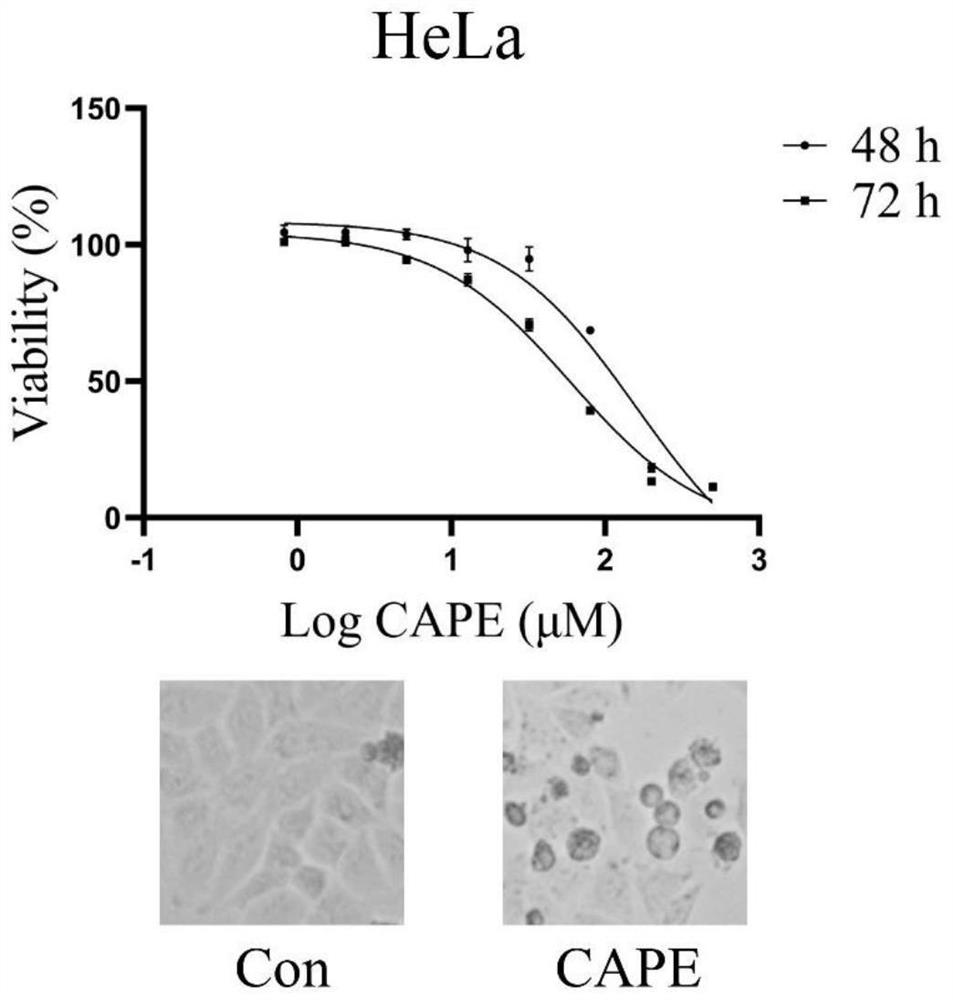Application of phenethyl caffeate in preparation of anti-cervical cancer drugs
A technology of phenethyl caffeate and cervical cancer, which is applied in the field of medicine and can solve problems such as tissue damage, drug resistance, and poor radiosensitivity
- Summary
- Abstract
- Description
- Claims
- Application Information
AI Technical Summary
Problems solved by technology
Method used
Image
Examples
Embodiment 1
[0052] Experimental purpose: To illustrate the effect of CAPE on growth inhibition of 4 kinds of human cervical cancer cells through CCK-8 and clone formation experiments.
[0053] Experimental design: On human cervical cancer cell lines HeLa, MS751, SiHa and Caski, CCK-8 and clone formation experiments were used to illustrate the effect of CAPE on growth inhibition of four human cervical cancer cell lines. The result is as Figure 1-8 shown.
[0054] Analysis of results: After CAPE treatment, the viability of HeLa, MS751, SiHa and Caski cells decreased significantly.
[0055] The results showed that CAPE can inhibit the growth of cervical cancer cells.
Embodiment 2
[0057] Experimental purpose: To illustrate the effect of CAPE on apoptosis of cervical cancer cells by TUNEL and Western Blot experiments.
[0058] Experimental design: On human cervical cancer cells HeLa and SiHa, the effect of CAPE on cervical cancer cell apoptosis was determined by TUNEL and Western Blot. The result is as Figure 9-16 shown.
[0059] Analysis of the results: After CAPE treatment, the apoptosis levels of HeLa and SiHa cells were significantly increased.
[0060] The results showed that CAPE could promote the apoptosis of cervical cancer cells.
Embodiment 3
[0062] Experimental purpose: To illustrate the effect of CAPE on the interaction between E6AP and p53 through co-immunoprecipitation experiments.
[0063] experimental design:
[0064] On human cervical cancer cell lines HeLa, MS751, SiHa, Caski and HEK 293T cells, the changes in the interaction level of E6AP and p53 after CAPE treatment were determined by co-immunoprecipitation method. The result is as Figure 17-21 shown.
[0065] Analysis of results: After CAPE treatment, the level of E6AP combined with p53 was significantly reduced, and the interaction between the two was weakened.
[0066] The results indicated that CAPE could inhibit the interaction between E6AP and p53 and reduce the combination of the two.
PUM
 Login to View More
Login to View More Abstract
Description
Claims
Application Information
 Login to View More
Login to View More - R&D
- Intellectual Property
- Life Sciences
- Materials
- Tech Scout
- Unparalleled Data Quality
- Higher Quality Content
- 60% Fewer Hallucinations
Browse by: Latest US Patents, China's latest patents, Technical Efficacy Thesaurus, Application Domain, Technology Topic, Popular Technical Reports.
© 2025 PatSnap. All rights reserved.Legal|Privacy policy|Modern Slavery Act Transparency Statement|Sitemap|About US| Contact US: help@patsnap.com



